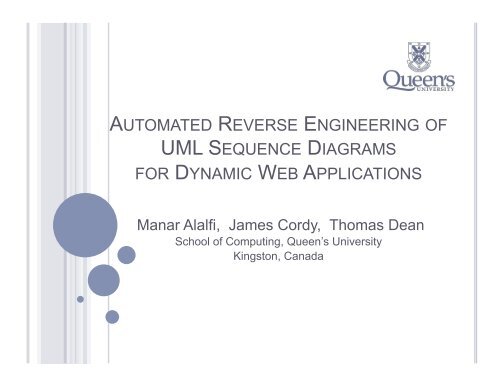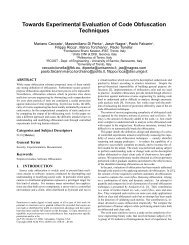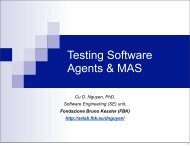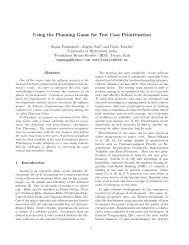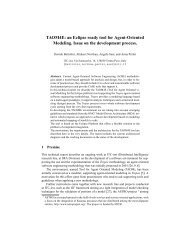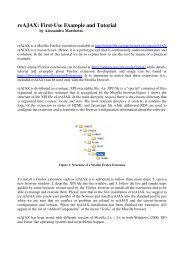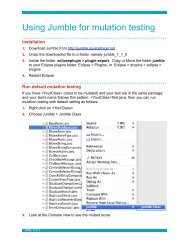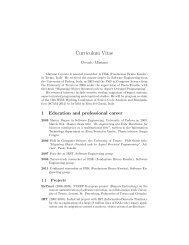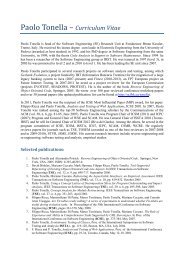automated reverse engineering of uml sequence ... - FBK | SE
automated reverse engineering of uml sequence ... - FBK | SE
automated reverse engineering of uml sequence ... - FBK | SE
- No tags were found...
Create successful ePaper yourself
Turn your PDF publications into a flip-book with our unique Google optimized e-Paper software.
CONTEXT Part <strong>of</strong> a FrameworkPHP TXLGrammarTXLTransformationRulesPHPDocumentsMySql TXLGrammarTXLTransformationRulesDatabaseschema Role-based access controlsecurity testing usingmodel checking [C3S2E09]Identification <strong>of</strong>Users, Roles,ResourcesXMI SecureUMLModelStatic AnalysisInstrumentationStaticAnalysisXMI to FormalModeltransformationAccess controlpropertiesMutantOperatorsInstrumentedPHP documentsStaticInformationModelCheckerRandomUserInputMutantInstrumentedPHP documentsSequenceDiagramClassDiagramCorrectCounterExampleExecutionTracesDynamicInformation
CONTEXT PHP2XMIPHP TXLGrammarTXLTransformationRulesPHPDocumentsMySql TXLGrammarTXLTransformationRulesDatabaseschema Used to recover rolepermissions at the level <strong>of</strong>page access (this work)Identification <strong>of</strong>Users, Roles,ResourcesXMI SecureUMLModelStatic AnalysisInstrumentationStaticAnalysisXMI to FormalModeltransformationAccess controlpropertiesMutantOperatorsInstrumentedPHP documentsStaticInformationModelCheckerRandomUserInputMutantInstrumentedPHP documentsSequenceDiagramClassDiagramCorrectCounterExampleExecutionTracesDynamicInformation
WEB APPLICATION CHALLENGES Identification <strong>of</strong> interaction elements Web applications <strong>of</strong>ten not built based on OO concepts Identification <strong>of</strong> control structures (loops and conditions) Multiple entry points Implicit control flow that is difficult to detect until run time Recognition <strong>of</strong> similar execution trace patterns Using both static and run time information Representation <strong>of</strong> the complete set <strong>of</strong> behavioral changes fromstate to state Several components may be affected Databases, sessions, cookies Multilingual documents
MOTIVATION PHP2XMI is a key part <strong>of</strong> our role-based access control (RBAC)security analysis framework Used to recover role permission behavior at the page access level Why UML Sequence Diagrams ? Standard for behavior representation Facilitates the process <strong>of</strong> understanding system interaction behaviorusing standard UML tools Helps in inferring user role permissions Why UML 2.0 in XMI 2.0 format? International standard for UML model representation and interchange Easy interchange with UML-based modeling tools such as RationalS<strong>of</strong>tware Architect Supports model integration and model to model transformation
GOALS & CONTRIBUTIONS A new <strong>reverse</strong> <strong>engineering</strong> tool for dynamic web applications PHP-based dynamic web applicationsUML 2.1 <strong>sequence</strong> diagrams Adaptable behavioral model recovery technique Extendable to other scripting languages in plug-and play fashion Handles mixed-language documents Facilitates testing for web application security vulnerabilities Dynamic trace filtration Reduces redundant information that can complicate programunderstanding Supports Model-Driven-Engineering Result can be directly imported and visualized using standardUML toolsets such as Rational S<strong>of</strong>tware Architect
PHP2XMI - APPROACHDynamic PHPWeb ApplicationInstrumented PHPApplicationTest CasesWeb crawlingToolInstrumentingTransformationInstrumentingFunction LibraryFilteringBrowserSession Three stagesSQL TraceDatabaseTrace to XMITransformation Instrument, exercise, extract modelXMI 2.1SequenceModelRationalS<strong>of</strong>twareArchitectUML 2.1SequenceDiagram
PHP2XMI - APPROACHDynamic PHPWeb ApplicationInstrumented PHPApplicationTest CasesWeb crawlingToolInstrumentingTransformationInstrumentingFunction LibraryFilteringBrowserSession Three stagesSQL TraceDatabaseTrace to XMITransformation Instrument, exercise, extract modelXMI 2.1SequenceModelRationalS<strong>of</strong>twareArchitectUML 2.1SequenceDiagram
PHP2XMI - APPROACHDynamic PHPWeb ApplicationInstrumented PHPApplicationTest CasesWeb crawlingToolInstrumentingTransformationInstrumentingFunction LibraryFilteringBrowserSession Three stagesSQL TraceDatabaseTrace to XMITransformation Instrument, exercise, extract modelXMI 2.1SequenceModelRationalS<strong>of</strong>twareArchitectUML 2.1SequenceDiagram
PHP2XMI - APPROACHDynamic PHPWeb ApplicationInstrumented PHPApplicationTest CasesWeb crawlingToolInstrumentingTransformationInstrumentingFunction LibraryFilteringBrowserSession Three stagesSQL TraceDatabaseTrace to XMITransformation Instrument, exercise, extract modelXMI 2.1SequenceModelRationalS<strong>of</strong>twareArchitectUML 2.1SequenceDiagram
PHP2XMI - APPROACHDynamic PHPWeb ApplicationInstrumented PHPApplicationTest CasesWeb crawlingToolInstrumentingTransformationInstrumentingFunction LibraryFilteringBrowserSession Three stagesSQL TraceDatabase Instrument, exercise, extract model Source transformation basedTrace to XMITransformationXMI 2.1SequenceModelRationalS<strong>of</strong>twareArchitectUML 2.1SequenceDiagram
STAGE 1 - INSTRUMENTDynamic PHPWeb ApplicationInstrumented PHPApplicationTest CasesWeb crawlingToolInstrumentingTransformationInstrumentingFunction LibraryFilteringBrowserSessionSQL TraceDatabase Parsing and insertion <strong>of</strong> dynamicinstrumentation code Source transformation using TXLTrace to XMITransformation Adaptable to any scripting language,mixed languagesXMI 2.1SequenceModelRationalS<strong>of</strong>twareArchitectUML 2.1SequenceDiagram
STAGE 1 - INSTRUMENT Parsing and insertion <strong>of</strong>dynamic instrumentation code
STAGE 1 - INSTRUMENT Parsing and insertion <strong>of</strong>dynamic instrumentation code
STAGE 2 - EXERCI<strong>SE</strong>Dynamic PHPWeb ApplicationInstrumented PHPApplicationTest CasesWeb crawlingToolInstrumentingTransformationInstrumentingFunction LibraryFilteringBrowserSessionSQL TraceDatabase Dynamic test case generation andscripting, using WATIR open source tool Web Application Testing In RubyTrace to XMITransformation Scriptable library to drive browser by clickinglinks, pressing buttons, filling in formsXMI 2.1SequenceModelRationalS<strong>of</strong>twareArchitectUML 2.1SequenceDiagram
STAGE 2 - EXERCI<strong>SE</strong>Dynamic PHPWeb ApplicationInstrumented PHPApplicationTest CasesWeb crawlingToolInstrumentingTransformationInstrumentingFunction LibraryFilteringBrowserSessionSQL TraceDatabase Automatic trace collection frominstrumentation No human interactionTrace to XMITransformationXMI 2.1SequenceModelRationalS<strong>of</strong>twareArchitectUML 2.1SequenceDiagram
STAGE 2 - EXERCI<strong>SE</strong>Dynamic PHPWeb ApplicationInstrumented PHPApplicationTest CasesWeb crawlingToolInstrumentingTransformationInstrumentingFunction LibraryFilteringBrowserSessionSQL TraceDatabase Automatic dynamic filteringTrace to XMITransformation Avoids unmanageably large trace database Automatically minimizes unique paths, loops New page, old page with new parameters, oldpage with same parameters but new pathXMI 2.1SequenceModelRationalS<strong>of</strong>twareArchitectUML 2.1SequenceDiagram
STAGE 2 - EXERCI<strong>SE</strong> Automatic dynamic filtering
STAGE 2 - EXERCI<strong>SE</strong>
STAGE 3 – EXTRACT MODELDynamic PHPWeb ApplicationInstrumented PHPApplicationTest CasesWeb crawlingToolInstrumentingTransformationInstrumentingFunction LibraryFilteringBrowserSessionSQL TraceDatabaseTrace to XMITransformation Database analysis and model generation Transformation from trace DB to UML 2.0<strong>sequence</strong> model in XMI 2.1 Visualized and refined using any UML 2.0toolsetXMI 2.1SequenceModelRationalS<strong>of</strong>twareArchitectUML 2.1SequenceDiagram
STAGE 3 – EXTRACT MODEL Database analysis andmodel generation
Browser session and unique pages // / // LifelinesPage transitions with parameters /Messages/Page transaction time MessageOccurrenceSpecification ///(Sending)MessageOccurrenceSpecification /(Receiving)BehaviorExecutionSpecification
CURRENT STATUSPHP TXLGrammarTXLTransformationRulesPHPDocumentsMySql TXLGrammarTXLTransformationRulesDatabaseschema Phase 1 (Behavior) PHP2XMI Completed, tuning(this work)Identification <strong>of</strong>Users, Roles,ResourcesXMI SecureUMLModelStatic AnalysisInstrumentationStaticAnalysisXMI to FormalModeltransformationAccess controlpropertiesMutantOperatorsInstrumentedPHP documentsStaticInformationModelCheckerRandomUserInputMutantInstrumentedPHP documentsSequenceDiagramClassDiagramCorrectCounterExampleExecutionTracesDynamicInformation
CURRENT STATUSPHP TXLGrammarTXLTransformationRulesPHPDocumentsMySql TXLGrammarTXLTransformationRulesDatabaseschema Phase 2 (Structure) Extracts ER class model Completed, tuning[WCRE 08]Identification <strong>of</strong>Users, Roles,ResourcesXMI SecureUMLModelStatic AnalysisInstrumentationStaticAnalysisXMI to FormalModeltransformationAccess controlpropertiesMutantOperatorsInstrumentedPHP documentsStaticInformationModelCheckerRandomUserInputMutantInstrumentedPHP documentsSequenceDiagramClassDiagramCorrectCounterExampleExecutionTracesDynamicInformation
CURRENT STATUSPHP TXLGrammarTXLTransformationRulesPHPDocumentsMySql TXLGrammarTXLTransformationRulesDatabaseschema Phase 3 (Unify) Unified security model Completed, tuningIdentification <strong>of</strong>Users, Roles,ResourcesXMI SecureUMLModelStatic AnalysisInstrumentationStaticAnalysisXMI to FormalModeltransformationAccess controlpropertiesMutantOperatorsInstrumentedPHP documentsStaticInformationModelCheckerRandomUserInputMutantInstrumentedPHP documentsSequenceDiagramClassDiagramCorrectCounterExampleExecutionTracesDynamicInformation
CURRENT STATUSPHP TXLGrammarTXLTransformationRulesPHPDocumentsMySql TXLGrammarTXLTransformationRulesDatabaseschema Phase 4 (Model check) Model checking <strong>of</strong> unifiedmodel for access control In progressIdentification <strong>of</strong>Users, Roles,ResourcesXMI SecureUMLModelStatic AnalysisInstrumentationStaticAnalysisXMI to FormalModeltransformationAccess controlpropertiesMutantOperatorsInstrumentedPHP documentsStaticInformationModelCheckerRandomUserInputMutantInstrumentedPHP documentsSequenceDiagramClassDiagramCorrectCounterExampleExecutionTracesDynamicInformation
RELATED WORK IN BEHAVIORAL MODELS Many techniques for standard OO systems CPP2XMI, Briand et al., … Do not deal with web applications, mixed languages Mostly use XMI 1.0 (old standard) - not compatible with UML tools Other web application techniques recover behavioral models But in custom formats, not UML standard <strong>sequence</strong> diagrams Ricca and Tonella (ReWeb, TestWeb(2001)) UML object model + custom behavioral model format Aimed at generating test cases Antoniol et al. (WANDA) Execution traces are not filtered, scalability problems UML <strong>sequence</strong> diagram + other models, in custom model format Overhead in processing multilingual documents Di Lucca and Di Penta (filtered WANDA) Statically identify and cluster equivalent web application client pages Does not preserve all possible paths the application allows users
CONCLUSION PHP2XMI: a new <strong>reverse</strong> <strong>engineering</strong> tool fordynamic behavior <strong>of</strong> web applications Scalable, adaptable model recovery Largely language independent Automated instrumentation Dynamic trace filtration Uses UML / XMI 2.1 standards Supports web application validation and security testingusing standard tools
CURRENT AND FUTURE WORK Coverage Enumerate all possible executions for each role Added coverage instrumentation to assure accuracyand completeness <strong>of</strong> the generated <strong>sequence</strong> diagram By unique page, PHP function, SQL query/update, HTTP var Level <strong>of</strong> detail Raise the <strong>sequence</strong> diagram to the entity level from thepage level Integrate <strong>sequence</strong> diagrams from different sessionsinto a <strong>sequence</strong> diagram for the entire web application Generalization Testing <strong>of</strong> other web application vulnerabilities Other scripting languages Extension to web services
?AUTOMATEDQUESTIONS?REVER<strong>SE</strong> ENGINEERING OFUML <strong>SE</strong>QUENCE DIAGRAMSFOR DYNAMIC WEB APPLICATIONSManar Alalfi, James Cordy, Thomas Dean


